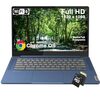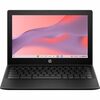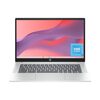Netbook vs Notebook: What's the difference?
In this video Albert of com.puter.tv explains the differences between netbooks and notebooks using the Acer Aspire One netbook and a Toshiba Notebook as example devices. The main differences are summarized below:
- Netbooks are smaller and weigh less than notebooks.
- Netbooks usually have screen sizes of 7", 9" or 10" whereas common screen sizes of notebooks are 12.1", 13.1", 13.3", 14.1", 15.4, 17" or even larger.
- Netbooks offer less power, memory and storage than notebooks and thus do not enable the same capabilities for running operating systems and applications. Netbooks are focused on net-centric tasks, — that's why they are called netbooks — such as browsing the web, reading and writing e-mail or using web applications.
- Netbooks can be used for more sophisticated tasks, but they will take more time compared to the more powerful notebooks. You would not want to use netbooks for editing or converting videos for example.
- Currently there is no netbook that has a disc drive, so you cannot play CDs or watch DVDs on netbooks. Of course you can play media from a netbook's hard drive.
- Netbooks are usually cheaper than notebooks.
- Netbooks consume less power and thus usually have a longer battery life than notebooks.
• Technology explained Netbook vs Notebook Netbook Buying Guide
To be informed of new posts, subscribe to the RSS feed or follow Linux Netbook on Facebook.
Affiliate Disclosure: External links on this website may contain affiliate IDs, which means that I earn a commission if visitors make a purchase via such a link. For details, see the disclosure page.





